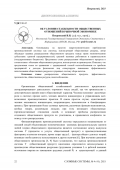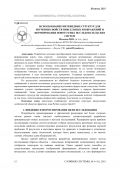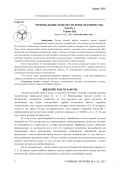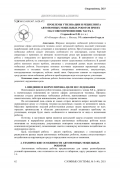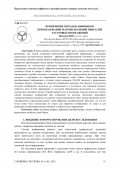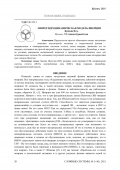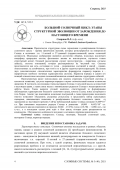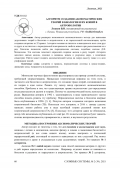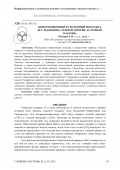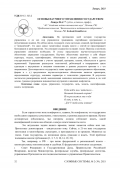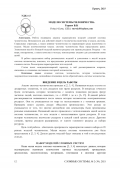Основываясь на простом макроэкономическом приближении производственной системы как системы, использующей общественные ресурсы, автор обсуждает правила распределения общественного продукта между тремя экономическими субъектами: группой предпринимателей, группой наемных работников и правительством (государственным бюджетом). Предложена схема распределения общественного продукта в соответствии с объемами общественных ресурсов, используемых в производстве. Показано, что предлагаемая схема по сравнению с традиционной схемой налогообложения по прибыли предприятий и доходов физических лиц стимулируют повышение эффективности использования общественных ресурсов и упрощает систему сбора налогов.
Разработана методика преобразования пиксельных изображений с целью
формирования нового типа структур – названных автором нитевидными, обладающих
свойством выявлять существенные особенности преобразуемых объектов. Также разработана программа на языке Python с использованием модуля компьютерного зрения OpenCV и модуля работы с массивами данных Numpy, позволяющих эффективно обрабатывать исходные пиксельные изображения и визуализировать сформированные на их основе нитевидные отображения. Описаны как принципы разработанного метода, так и основные действия, осуществляемые в ходе исполнения кода программы. Созданная программа отличается простотой использования и возможностью регулирования шага расположения нитей. По результатам экспериментов по обработке большого количества разнородных изображений и анализа полученных результатов сделаны выводы и даны рекомендации по перспективам применения нитевидных структур в различных сферах науки и искусства. Особое внимание уделено преобразованию широко распространённых в природе фрактальных изображений. Также рассмотрено потенциальное удобство применения разработанных нитевидных структур при совершенствовании процедур распознавания нечётких изображений (в том числе с использованием нейросетей), например, полученных со спутников.
Целью данной работы является анализ первой региональной модели системы человечества. Эта модель входит в набор из 28 моделей человечества. Элементами этих моделей являются ресурсы или группы ресурсов.
Ранее была представлена малая количественная модель системы всего человечества. Под
ресурсами мы понимаем инструменты, вещи, качества и методы, которые можно использовать для достижения человеческих целей. В наших моделях системы человечества возможности для действий людей и человечества включены в рассмотрение, а социальные структуры, а также влияние человечества на окружающую среду исключены из рассмотрения.
Всего предложено 26 региональных моделей. Это модели ресурсных групп. В статье
представлены детали первой региональной модели системы человечества и график развития на протяжении жизни первой региональной модели. В совокупности региональные модели составляют большую модель человечества.
Эта статья носит междисциплинарный характер, поскольку в ней рассматриваются
вопросы, связанные со сложными системами и историей человечества.
Широкое внедрение мобильной робототехники в различные сферы деятельности человека делает актуальной проблему массовой утилизации выработавших свой ресурс, устаревших и неисправных роботов. При утилизации каждого типа мобильных роботов следует учитывать особенности его конструкции, состав бортовой аппаратуры и принимать во внимание экологические риски при разрушении конструкции робота с попаданием его фрагментов в окружающую среду. В зависимости от вида и назначения роботов, их утилизация и рециклинг имеют существенные особенности. В данной работе выполнен анализ проблем, связанных с утилизацией разных видов автономных мобильных роботов. Рассмотрены основные источники загрязнения окружающей среды, имеющиеся в составных частях роботов: электронных компонентах, аккумуляторах, конструкционных материалах, кабелях линий связи. Определено влияние на окружающую среду разных типов мобильных роботов и преобладающие виды отходов при их утилизации.
В рамках работы ставились следующие цели: создание метода, алгоритма и программы для сжатия растровой (пиксельной) графической информации с помощью специальных математических приёмов – аффинных преобразований. Основной задачей было обеспечение высокой степени сжатия изображений при минимальном ухудшении их качества. Разработан оригинальный метод замены большого количества пиксельных блоков исходного изображения на относительно небольшое количество наиболее подходящих специально создаваемых доменных блоков. Аффинное преобразование заключается в перемещении любого доменного блока из набора в любую часть изображения, при этом должно обеспечиваться максимальное подобие исходных и доменных блоков. Для осуществления метода разработан алгоритм и программа на современном популярном языке Python. Рассмотрен пример преобразования изображения в оттенках серого размером 256x256 пикселей с применением доменных блоков, созданных из областей изображения размером 4x4 пикселя. В результате получено изображение, визуально не отличающееся от исходного, для описания которого требуется всего 0,3125 информации от исходной. Произведены вычисления и с меньшим количеством доменных блоков. Разработанный метод и программа доказали высокую степень сжатия растровых изображений при сохранении их качества. Возможно дальнейшее совершенствование описанного алгоритма и представленной на сайте автора программы путём одновременного применения разных типов аффинных преобразований. Показано, что тот же метод может быть использован не только для обработки изображений, но также и для выявления подобия (фрактальных свойств) в любом потоке информации.
Закономерности развития производственной системы обсуждаются на основе представления о том, что прогресс в хозяйственной деятельности человека связан с успехами в технологическом использовании усилий человека и источников энергии, которые рассматриваются как важнейшие общественные производственные ресурсы. Введено понятие замещающей работы оборудования P, которая во всех отношениях эквивалентна усилиям людей в производстве, может считаться услугой капитала и рассматриваться как стоимость-образующий фактор, наряду с традиционными производственными факторами. Выпуск системы (производство стоимости) определяется как функция трёх переменных, две из которых: трудозатраты L и замещающая работа P рассматриваются как активные источники стоимости, что позволяет ввести энергетическую меру стоимости, а физический капитал K, как производственный фактор, играет пассивную роль. При предположении, что производственная система стремится использовать все доступные общественные ресурсы, определённые внешними по отношению к системе обстоятельствами, формулируются уравнения для производственных факторов, которые сопровождаются также уравнениями для технологических характеристик производственного оборудования. Траектория развития системы определяется характеристиками самой системы и доступностью общественных ресурсов, которые не могут быть использованы полностью одновременно, что приводит к смене мод развития и колебаниям выпуска – деловым циклам. На примере экономики США демонстрируется, что система уравнений способна описывать наблюдаемую траекторию развития и выпуск производственной системы.
Предлагается простое объяснение самым загадочным понятиям классической механики и теоретической физики – инерциальным и неинерциальным системам отсчета, силам инерции, движению тел по инерции, основанное на простой вихревой модели твердых тел и парадоксе Даламбера, а также, на условиях равновесия несжимаемой жидкости и принципа присоединенных масс для потенциальных потоков. На основании полученной модели представлена новая интерпретация трех законов Ньютона.
Предлагается структурная схема зарождения и развёртывания большого солнечного цикла – группы физических явлений, которые регистрируются на поверхности Солнца и включают т.н. 11-летний и 27-дневный (кэррингтоновский) циклы солнечной активности. Модельные соображения являются достаточно общими, поскольку исключают специфику природных систем; физические законы не используются, изучается только структурный аспект. Основой рассмотрения служит протоструктура – первичная, согласно замыслу, система отношений, которая рассматривается на числовой оси. Система представляется как сеть, состоящая из узлов – разрешенных состояний и связей – правил, ответственных за устойчивость, при этом и те и другие задаются протоструктурой. На основе двух дополнительных относительных характеристик формируется параметр порядка n – иерархически наиболее значимая характеристика системы. Параметр порядка и сдвиги его позиций относительно исходных положений являются основой анализа структурных событий.
Протоструктура ранее использована для анализа структуры Солнечной системы в плоскости эклиптики, где роль параметра порядка n играет относительный момент количества движения. В частности, исследованы этапы выгорания Солнца от исходной массы до известной в настоящее время, а также связь массы с минимальным радиусом Солнца и эксцентриситетом орбиты Земли. Также выявлен узловой комплекс, ответственный за формирование наблюдаемых характеристик большого солнечного цикла, кометы Галлея, пояса астероидов и тела Хирон. Анализ уже имеющихся модельных построений, а также привлечение нескольких гипотез позволяют объединить указанные результаты и представить набор структурных сценариев, описывающих появление и развёртывание большого солнечного цикла от зарождения до настоящего времени. Сейчас наблюдаемый радиус Солнца составляет 4,649*10-3 а.е. При изменении модельного радиуса Солнца в диапазоне (4,800 – 4,642)*10-3 а.е. длительности циклов изменяются в пределах (9,666 - 27,276) суток и (18,784 – 11,086) лет., где r3=а.е., а в последнем случае речь идёт о ба
Автор расширил возможности аксиоматического метода для написания дедуктивных теорий в биологии и антропологии и их параллельной систематизации, путём создания алгоритма из 32 правил. Алгоритм основан на гипотезе о выводимости всех слов друг из друга и на гипотезе о периодической повторяемости свойств живого при расположении их в ряд. Гипотезы позволили найти две периодические системы, подобные системе Д.И. Менделеева. Эти системы помогают определять порядок аксиом в ряду теорий. Алгоритм дополнен связью аксиом, сходных в неживом, живом и разумном мире, с понятиями симметрии. Работа может поднять аксиоматический метод на новую высоту также и в деле унификации знаний.
Обсуждаются нефизические подходы к определению природы «темной энергии» и «темной материи» в связи с тем, что физическая природа названных явлений до сих пор не определена. Показана возможность рассмотрения информации наравне с материей и энергией. Данная возможность обосновывается результатами психологических исследований в рамках теории интегральной информации, результатами физических исследований в рамках гипотезы самосимуляции и принципа массо-энерго-информационной эквивалентности Вопсона, а также результатами системных исследований средствами системно-объектного подхода. Исследуется системная природа Универсума. Средствами системно-объектного подхода обосновывается его информационная структура в виде иерархии систем-классов (концептуальных систем), которая определяет свойства систем-явлений (материальных систем), обеспечивающих реальные взаимодействия. Утверждается подобие иерархии систем-классов Универсума иерархии понятий в сознании человека на уровне словесно-логического мышления. Представленные результаты поддерживают известную формулировку сильного антропного принципа. Показана связь свойств иерархии систем-классов и известных свойств «темной энергии» и «темной материи».
На протяжении всей истории государства управлялись и до сих пор управляются традициями, партийными программами и интуитивными идеями. Но сейчас жизнь государств стала настолько сложной, противоречивой и “динамичной”, что даже самые талантливые лидеры вместе с элитой не предотвращают беспорядков и кровопролития. Эта ситуация ухудшается на наших глазах. Переход к научному управлению жизненно необходим. В статье представлено научно-методологическое обеспечение управления государствами. Научное обеспечение включает в себя общую структуру, модель, идентификацию, обоснование и анализ решений, а также синтез государственного управления с учетом традиций, программ, планов, обязательств и других ограничений. Управление реализуется технологией, работающей в непрерывном цикле адаптации к внутренним и внешним изменениям в режиме реального времени и с его опережением. Для конкретного государства (а также крупного административного образования, фирмы и т. д.) предлагаемое научно-методическое обеспечение является ориентиром, определяющим структуру, основные параметры и технологию управления. В результате достигается ранжирование целей, максимизация социально-экономического успеха и, на этой основе, гуманное разрешение имманентных внутренних и внешних конфликтов.
Работа посвящена анализу характеристик моделей сложной системы человечества. Возможности для действий людей и человечества включены в модель системы. Социальные структуры, а также влияние человечества на окружающую среду исключены из модели. Малая количественная модель системы человечества была представлена ранее. Элементами малой и большой моделей являются ресурсы или группы ресурсов. Ресурсы – это вещи, инструменты, а также качества и методы, используемые людьми для достижения своих целей.
В работе представлен набор региональных моделей в дополнение к малой модели системы человечества, показано, что предлагаемые региональные модели являются моделями сложных систем. Рассмотрены характеристики этих моделей.
Статья носит междисциплинарный характер, в ней рассматриваются вопросы, связанные со сложными системами и историей человечества.
